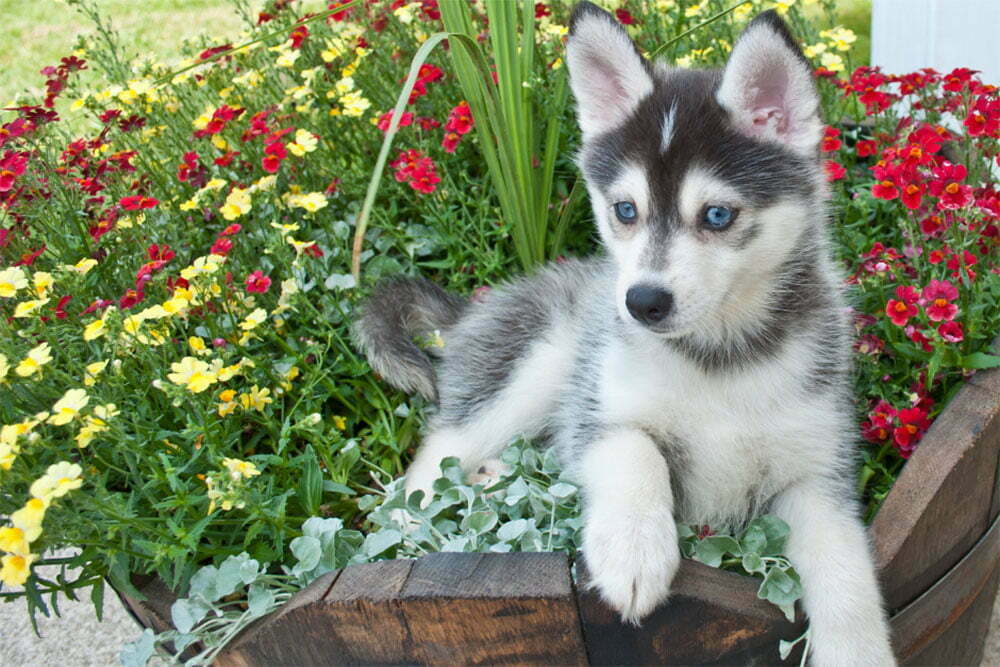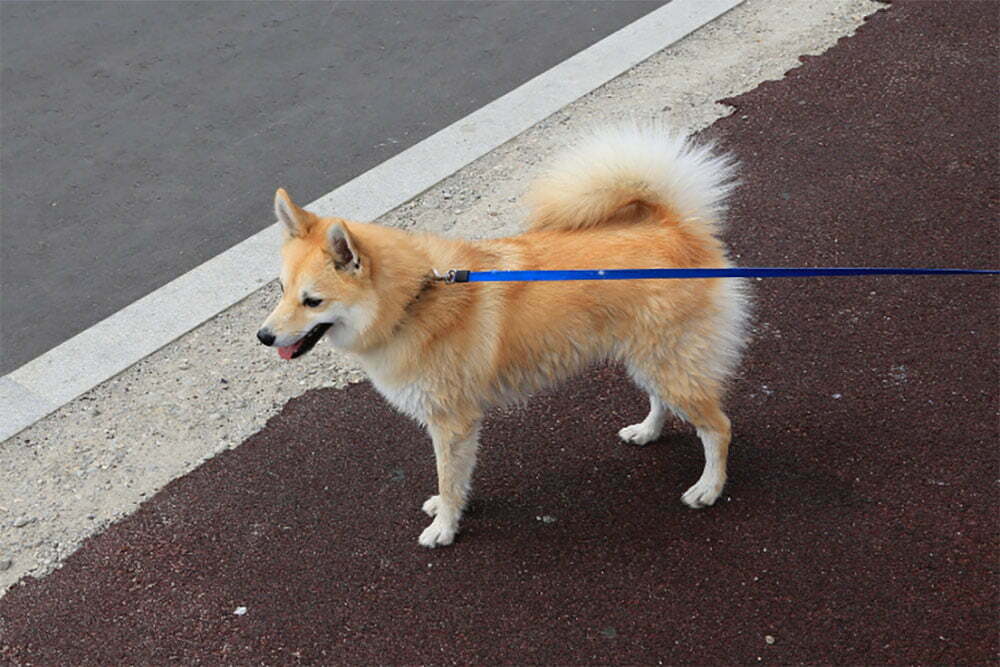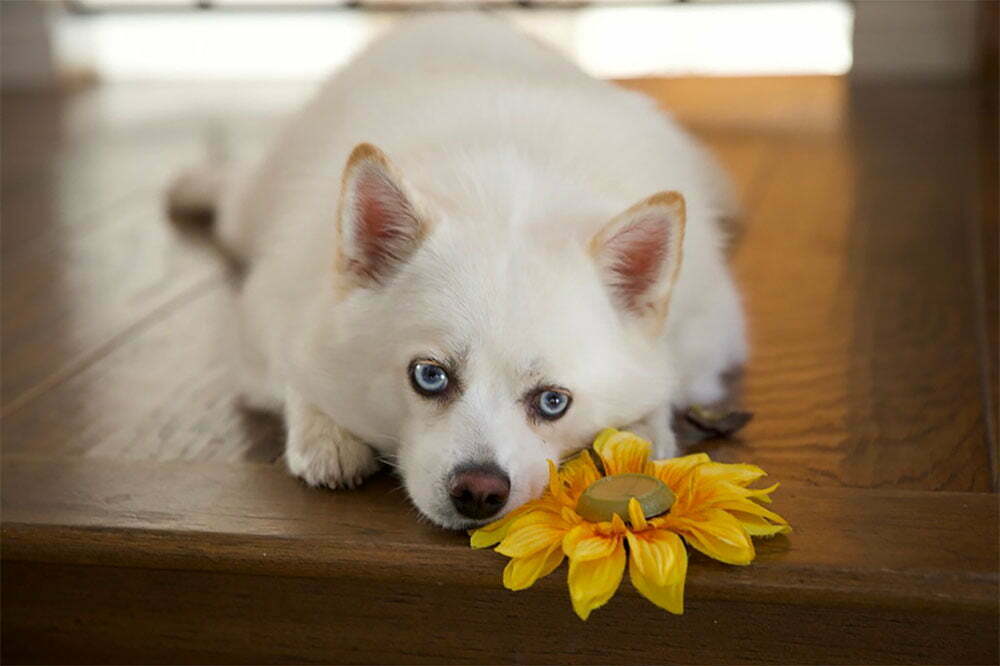Have you got your heart set on bringing a new furry friend into your home, but you’re not sure which breed of dog best suits you and your lifestyle? Well, this is the article for you!
Understanding everything there is to know about a dog breed before you add one to your life is super important because not all breeds will suit everyone. While it goes without saying that dogs are man’s best friend and owning one will, of course, bring years of happiness to your life, the wrong breed could also come with a lot of trouble.
So, without further ado, let’s get going! This article is the ultimate guide to owning a Pomsky: the super fluffy, friendly fur baby you need in your life!

The Pomsky is just one of the hundreds of mixed breeds that have risen in popularity in recent years. Hybrid breeds are awesome because they often get all the best bits of each parent breed! The Pomsky certainly attained the cuteness of its parents, in fact, many refer to this breed as a ‘designer dog’.
So, what is a Pomsky? The Pomsky dog is a mix between a Pomeranian and a Siberian Husky. So, if you’re looking for a dog that is super affectionate and easy to train, this is the dog for you!
But, as we said, before you take the plunge and settle on a Pomsky puppy, there are several important things you need to know about them first! While appearance is of course an important factor to consider, there are lots of others that come into play such as health issues, temperament, intelligence, and more.
What is a Pomsky?
Let’s kick off with the basics: what is a Pomsky? A fluffy Pomsky puppy will have one Pomeranian parent and one Siberian Husky parent.
To understand what to expect from a Pomsky, let’s take a look at both parent breeds:
Pomeranian
Pomeranians are known for being tiny, fluffy, and extroverted. What a lot of people don’t know about them are they also have a super affectionate nature.
Their fox-like looks make them a popular breed all over the world for owners from all walks of life. They have a gentle temperament, and they love to please, so positive reinforcement will work wonders on a Pomeranian.
They work well in a family environment and like to give everyone lots of affection. However, they do tend to form a particularly strong bond with one member of the family in particular.
Siberian Husky
Siberian Huskies are most commonly known for their sled-pulling abilities, but they’ve also become very popular household pets in recent years.
There’s no denying that this is one of the most beautiful dog breeds in the world which is why they are also one of the most wrongly purchased breeds too. Owning a Husky requires paying them a lot of attention and discipline, something that should not be taken lightly.
In general, this breed is affectionate and good-natured and fits in nicely within the family home. They also do very well in homes with multiple dogs.
They’re naturally very curious dogs, so it’s not recommended that they be left off their lead as they will likely run away and/or chase other animals.
Physical traits of a Pomsky
Pomsky dogs can vary in terms of size depending on what aspects of their parent breeds they possess.
Pomeranians tend to grow to between 7 and 12 inches tall and weigh between three and seven pounds which are very little compared to the Siberian Husky.
Siberian Huskies tend to grow to between 21 and 24 inches tall and can weigh between 45 and 60 pounds. Females tend to be a little smaller.
On average, Pomskies are medium-sized dogs and can grow to measure around 10 to 15 inches high and weigh between 20 and 30 pounds when fully grown.
Their fur is double-coated and dense but silky and can vary in color from brown, gray, black, white, and anything in between.
Their tails are super fluffy, with a strong arch over their back. Pomsky dogs’ bodies are pretty muscular with very strong legs and relatively wide shoulders.
The color of their eyes can vary greatly and could fall anywhere from blue to brown to hazel to amber. They may even have two different colored eyes.
Their ears are very fluffy and pointy and stand erect on top of their head.
Personality traits of a Pomsky
Pomskies are naturally affectionate but stubborn dogs and are known to be pretty vocal, a common trait in both Pomeranians and Siberian Huskies.
This means training your Pomsky as early on as possible is a must, so they immediately know where they stand within the ‘pack’.
If you live in an apartment or somewhere where noise is an issue, a Pomsky may be a little too noisy for your living arrangement.

That being said, it is an incredibly intelligent breed, and with consistent, positive reinforcement training, they can learn when to speak and when to be quiet.
This breed is likely to form a significant bond with one person in particular, generally whoever they see as the ‘master’ – most often, this will be the person that disciplines and/or feeds them the most. They are still affectionate towards the whole family, though.
Much like Pomeranians, Pomskies love attention and praise. They are likely to form a stronger bond with one person but are still very loving towards all members of the family.
Pomskies have quite a high prey drive, so you will need to be wary of them when around other small animals, but they tend to get on well with other dogs if you socialize them properly from a puppy.
Health traits of a Pomsky dog
Fortunately, Pomskies are pretty healthy dogs, but there are a few health concerns you should be aware of. These include:
- Patellar Luxation – a disease that affects their legs and is a common cause of ‘slipping knees,’ which is hereditary in Pomeranians making Pomskies likely to inherit it too. The knees basically slip out of place affection movement and cause pain
- Eye Problems – Pomskies can develop eye defects like progressive retinal atrophy and juvenile cataracts, as they are very common in Huskies. Juvenile cataracts can develop from as early as three months of age and, in extreme cases, can cause complete loss of vision
- Canine Hip Dysplasia – a painful arthritis of the hip joints that is inherited. The disease is progressive but can be treated relatively easily with certain exercises
- Collapsed Trachea – a condition in which the dog experiences severe respiratory pain and coughing. It can be a horrible condition if not controlled. If you think your dog has the symptoms, your vet can diagnose the condition with an x-ray
- Dental Problems – most dog breeds are prone to dental disease and other dental problems, and Pomskies are no exception. This will most commonly stem from poor dental hygiene. Pomskies should have their teeth cleaned a few times a week if not every single day, to prevent cavities and other dental problems. Symptoms include yellow/ brown stains, loose teeth, bleeding gums, cheek swelling, bad breath, red swollen gums, and more
- Hypothyroidism – a condition caused by the lack of hormones produced by the thyroid gland. Symptoms include weight gain, excessive fur loss, sensitive to the cold and a dull coat
How long does a Pomsky live?
There are lots of contributing factors to lifespan, including diet, exercise, pre-existing conditions, and other issues related to old age.
Pomeranians and Siberian Huskies are both breeds that tend to live long, healthy lives, with Pomeranians living between 12 and 16 years and Huskies living between 12 and 15 years.
The Pomsky breed is still a relatively new breed, so their average lifespan is still only an estimation, but scientists believe a healthy Pomsky will live on average from 13 to 15 years.
How to take care of a Pomsky dog
Exercising
Pomskies require daily exercise like any other breed. Ideally, they should get up to an hour per day, but this can be spread throughout the day.
If you don’t have time to take them on multiple small walks a day, Pomskies love to engage in mental and physical stimulation, so playing fetch or giving them toys to play with is a great way to use up some of their energy.
When it comes to walks, Pomskies should be kept on a leash as the Husky in them makes them likely to run off and chase other animals.
Training
Pomskies are very intelligent dogs, so training them can be pretty easy if you start early. Siberian Huskies are pretty stubborn so if your Pomsky puppy has attained that attribute, letting them know who’s boss from the beginning is the best way to ensure they respect you.
While remaining firm is important when training Pomskies, enforcing positive reinforcement is important as you don’t want them to become anxious or fearful of training.
Pomskies are prone to small dog syndrome, especially if they haven’t been trained properly. If your dog has small dog syndrome, they tend to bark and jump for other dogs and sometimes people.
Another important trait to make sure you train out of them is yapping, as Pomskies are very vocal. While yapping in Pomskies is not always a sign of something negative, they use their voices to communicate with their owners too. To keep barking and yapping to a minimum, teach them the silent command.
Grooming
Both parent breeds are extremely fluffy and long-haired, so as you can imagine, Pomskies are shedders all year round, particularly in the spring and autumn.
Their fur requires brushing at least once a week to brush away the dead hair and prevent matting.
During the summer months, their long hair can be a little odorous, so they should have baths more often during these times.
As their hair can grow pretty long, it should be trimmed at least once or twice a year, particularly around the eyes and anus, for hygiene purposes.
Trim and file their nails every month or so and cleaning their ears once a week is an excellent way to prevent possible ear infections from debris and wax buildup.
To protect their teeth from dental issues, their teeth must be cleaned a couple of times a week or preferably once a day. You should do this as soon as you bring your Pomsky puppy home so they become comfortable with the experience.
The average price of a Pomsky
The Pomsky is a designer dog, so naturally, they come with a price to match. The cost of purchasing a Pomsky puppy can vary quite a lot depending on the breeder and other factors like appearance and lineage.

On average, the price of a Pomsky puppy can range from $500 to $4-5,000! This may seem like a vast range, but as Pomskies are a designer breed, they are valued for a number of different factors, such as eye color, parentage, and overall look.
While these dogs are incredibly popular, plenty of Pomskies are abandoned or put up for adoption each year. So, if you have the opportunity to rescue a Pomsky, this would help a pup in need and be a much cheaper option than buying from a breeder.
Frequently Asked Questions
Is a Pomsky a good family pet?
Pomskies are naturally loving and playful and fit in well with families with children and/or other pets. However, no small children should be left alone with a dog.
When they first meet strangers, they can be a little standoffish at first, so if your house has lots of visitors, your Pomsky will likely bark or appear territorial around them until they feel comfortable.
Do Pomsky’s dogs bark a lot?
Pomskies are naturally very vocal dogs; both parents (Pomeranian and Siberian Husky) are very vocal, so you can only expect a Pomsky to be the same.
If your Pomsky puppy is not properly trained, they can become ‘yappy,’ meaning they bark more often than they need to. This is not only annoying for you but for those living around you too.
Fortunately, Pomskies are very intelligent dogs so training them not to bark is relatively easy so long as you are firm and start as soon as possible.
Do Pomsky dogs like to be held?
Pomskies are very affectionate dogs, and they love to be cuddled. Their size makes them pretty easy to pick up and carry or cuddle on your lap.
Considering how affectionate these dogs are, you could assume that they have no problem being held, but this will really depend on the individual dog, as many factors come into play when it comes to what a dog likes and dislikes.
If being able to hold and/or carry your dog is important to you, they are easily trained, so if you condition them to be held from a young age, they should have no issue with it as they get older.
Are Pomsky dogs hypoallergenic?
Pomskies are, unfortunately, not hypoallergenic. Their fur is pretty long and sheds very often, particularly during autumn and spring.
If you do have allergies, a Pomsky is not the right dog for you, and you’ll quickly find that their hair gets pretty much everywhere!
Do Pomsky dogs get separation anxiety?
Pomskies generally do okay on their own. They’re very intelligent, so training them to get used to alone time should be pretty easy.
If you introduce them to spending time alone in your home little bits at a time from a young age, they should be pretty comfortable spending time alone.
The only issue with leaving them alone too long is that if they aren’t properly trained, they may become naughty and resort to chewing and destroying out of boredom.
Final Say
It’s clear that Pomsky dogs are super loving and cute and can quickly become a member of your family.
Many of their cute looks come from their long fluffy fur, which has its downsides. They shed a lot which can be annoying to clean up. They’re also not suitable for those who suffer from allergies.
Apart from that, Pomskies will make a great addition to most homes and will bring lots of affection, tons of fun, and a super smart best friend.
If all this sounds good, Pomsky dogs are the dogs for you!
